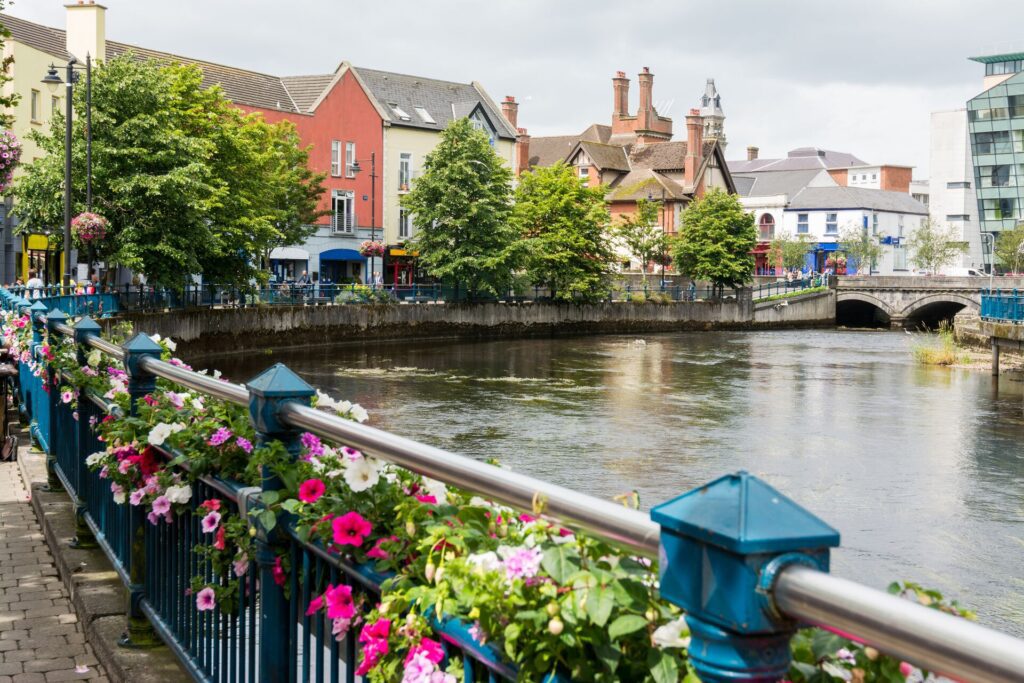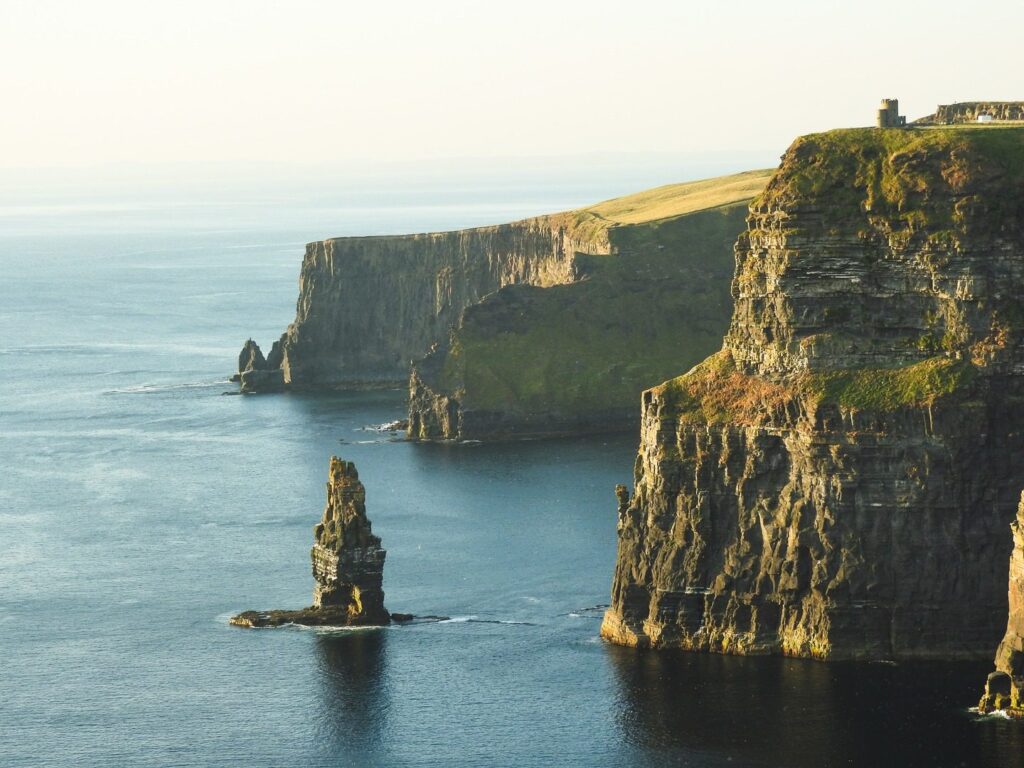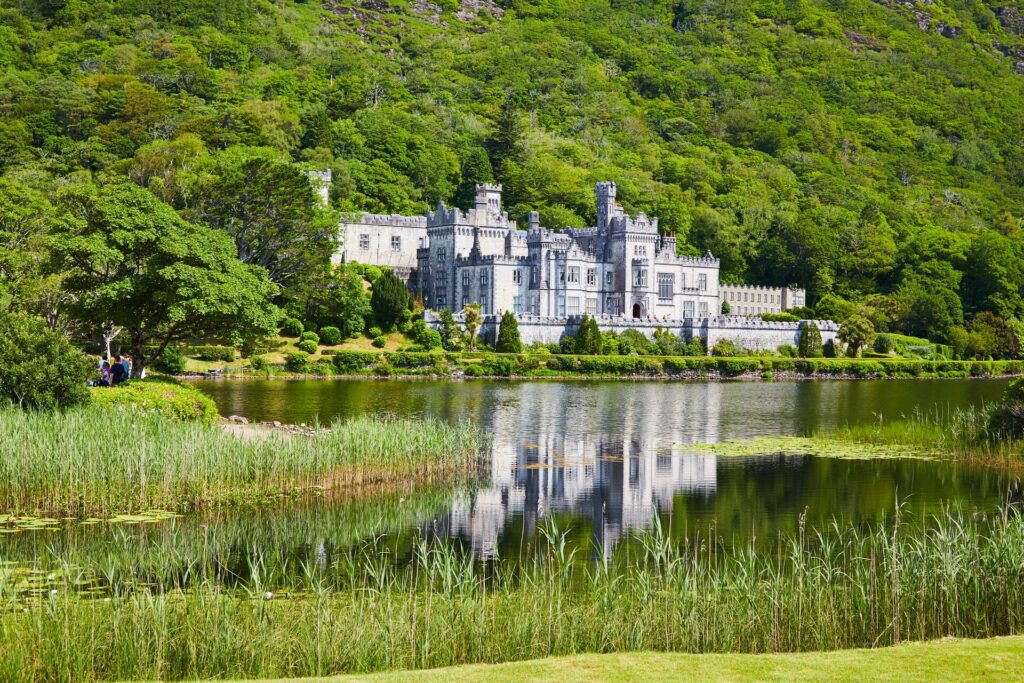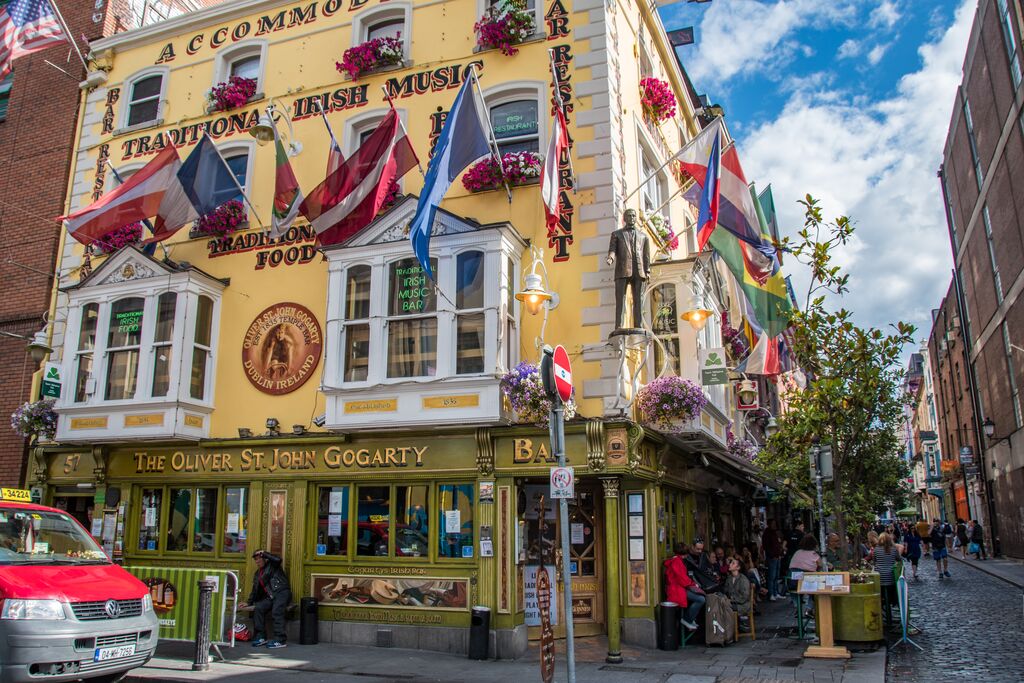Recently updated on October 16th, 2025 at 10:06 am
Thinking about visiting Ireland? Excellent, you’ve made a grand choice. In this article, you’ll find a comprehensive Ireland travel guide with everything you need to know before you go. Tips include how much to budget, advice on safety, and when’s the best time of year to visit. After one quick read, you’ll feel like you’ve known the Emerald Isle for years.
With dramatic coastlines, a rich history, and a lively arts scene, Ireland will charm you quicker than you can say céad míle fáilte. Discover the buzzing streets of Dublin, before heading to the cultural capital of Galway. Marvel at the mighty Cliffs of Moher and set your toes tapping to trad music in Dingle. Feeling lucky? Kiss the stone and get the “gift of the gab” at Blarney Castle. It may be small, but boy does Ireland pack a powerful punch.
When is the best time to visit Ireland?


We recommend visiting Ireland in the shoulder seasons for the best of the weather while avoiding the crowds. The ideal months to visit Ireland are May to June or mid-September through to mid-October, where you’ll have pleasant weather with high temperatures averaging around 17°C. Ireland is luscious and green year-round, however, there is the possibility of heavy rain in any month.
RELATED CONTENT: 7 photos that will make you fall in love with Ireland
Budgeting tips for Ireland
Ireland often has a reputation of being one of the most expensive countries in Europe. But with a little planning and smart thinking, it can be one of the most affordable countries to visit for a holiday.
There is so much to see and do in this green little isle and certain activities can start to add up. If you’re planning on visiting lots of sites in Dublin, it’s definitely worth getting a Go City Dublin Pass. It includes skip the line entry to over 30 attractions, hop-on hop-off bus access and a number of other discounts. As the most expensive city in the Republic of Ireland, this will certainly help your budget.
Overall, how much money you need for Ireland really depends on what type of holiday you are after. If you have booked onto a Trafalgar trip, the majority of your food, accommodation and activities are included. But here is a simple guide to follow if you plan on eating well, doing as many Optional Experiences as possible and buying a moderate amount of souvenirs:
Approximate daily costs:
- Lunch + drink = €20
- Dinner + drink = €30
- Optional Experience per day = €20 average*
- Souvenirs = €25
Total Per Day = €95
This can vary*
Things to do in Ireland


Starting in Dublin and ending in Kilkenny City, this is an easy to follow Ireland travel guide that loops nicely around the country. From dolphin watching in Dingle to star-gazing at the Ring of Kerry, here’s our top pick of the best things to do in Ireland.
Start off in Dublin
It makes sense to begin your Irish journey in the country’s capital of Dublin. Steeped in history, with more than 1,000 pubs across the city and home to locals renowned for being the greatest hosts in the world, Dublin certainly knows how to have fun. Explore historical landmarks such as Dublin Castle, the Guinness Storehouse, or the Book of Kells at Trinity College Library.
Head west to Galway City
Next up is Galway City, Ireland’s cultural heart and a must do on any trip to the Emerald Isle. Its energy and creativity have seen it designated the European Capital of Culture for 2020. You could argue its lively atmosphere is thanks to the students who make up 20% of the population, but whatever the secret ingredient is, you’ll quickly fall for its brightly painted pubs buzzing with live music, medieval streets brimming with boutique shops and Galway Bay’s delicious oysters. Visit during the Galway International Arts Festival for an unforgettable cultural experience.
Check out Connemara
Head further out to Connemara jagged stretch of coastline on Ireland’s west coast. Imagine: towering peaks, vast wetlands and white sandy beaches that would give the Caribbean a run for its money. While you’re there, be sure to visit Connemara National Park and Kylemore Abbey. Originally built in 1868 by a wealthy businessman and politician, this now Benedictine monastery, features a magnificent Victorian Walled Garden, pottery studio, craft shop and tea rooms which are open to visitors year round.
BE INSPIRED: Visit Ireland
Meet the Cliffs of Moher
Jaw-droppingly beautiful the Cliffs of Moher are 214m high cliffs with an entirely vertical drop. Definitely check out the high-tech visitor centre where the history of these inspiring cliffs is brought to life at the “Atlantic Edge” exhibition, a 19th-century lookout tower and a wealth of walking trails. We highly recommend visiting at sunset, the views are breathtaking as the sky turns a kaleidoscope of colours.
Head on down to Dingle Town
Head on down to Dingle Town Dingle Town sits on the edge of the Dingle Peninsula, on the southwest coast of Ireland’s Wild Atlantic Way. It’s a charming fishing port that has been winning over visitors from around the world, giving this town a cosmopolitan feel. Take your pick from dolphin watching, walking tours, listening to Trad music (Irish traditional folk music) at O’Flaherty’s Bar, or feasting on a hearty breakfast at Pantri Cafe. Dingle Town will quickly win your heart.
Kick back in Killarney
One of our favourite spots on our Ireland travel guide, Killarney has been welcoming visitors for more than 250 years and is ideal for exploring national parks such as Killarney National Park. Situated in some of the country’s most spectacular landscapes, Killarney is home to glimmering lakes, picturesque waterfalls and is surrounded by 1000m-plus peaks. Spot deer in Killarney National Park, take a boat trip from Lord Brandon’s Cottage to Ross Castle on Lakes of Killarney and admire the beauty of Torc Waterfall.
Go stargazing in the Ring of Kerry
This circular route is one of Ireland’s most enchanting landscapes. It’s a 120-mile stretch of stunning coastal views, you’ll pass pristine beaches, medieval ruins, mountains and loughs. A highlight of the ring is its centre. In 2014, the ring’s centre became the 700-sq-km Kerry International Dark-Sky Reserve. Definitely take the chance to view the stars in the only Gold Tier Dark Sky Reserve in the Northern Hemisphere. It really doesn’t get much better than stargazing to the sound of the ocean in Ireland’s pristine dark skies.
Enjoy the craic in Cork
Giving Dublin a run for its money, Cork is a thriving metropolis, home to food markets, historical monuments, lively pubs, festivals, art galleries and an opera house. While you’re there definitely make the trip to Blarney Castle. Built by the King of Munster in the 15th century, see if you can “get the gift of the gab” by kissing the Blarney Stone, found on the castle’s machicolations. According to tradition the stone grants its kissers the gift of eloquence and persuasiveness. Whilst you’re in town, check out the Guinness Cork Jazz Festival.
Welcome to Waterford
Waterford is Ireland’s oldest city, with Viking roots and the Viking Triangle cultural hub. Its history can be traced back to Viking times and in 2014 it celebrated its 1100th anniversary. The city is still in touch with its Norse roots at the Viking Triangle, a cultural hub home to three museums which tell the story of Ireland’s Middle Ages better than in any other city in the country.
RELATED CONTENT: 7 unique family experiences in Ireland
End your trip in Kilkenny City
Kilkenny City is picture-postcard Ireland with its ‘Medieval Mile’ of narrow lanes and historic buildings, along the bank of the River Nore. We recommend visiting Kilkenny Castle, an Anglo-Norman stone castle that sits majestically over the Nore River. In the castle basement, you’ll find the Butler Gallery, one of Ireland’s most important art galleries outside of Dublin.
Where to stay in Ireland


As part of our Ireland travel guide, we’ve found three of the coolest places to stay in Ireland, so if you’re looking for somewhere a little different to rest your head, then look no further.
CroPod, Glencolmcille, Co Donegal
Feel like you’ve stepped onto the set of the Lord of the Rings with a night’s stay at this charming little hobbit house. Cropod is an underground shelter with spectacular views over Glencolmcille. It’s designed to have a low impact on its natural surroundings and to make the most of a compact space. So sit back, relax and just take in those views.
Ashford Castle, Cong, Co Mayo
Enjoy an evening of royal splendour at 5 star hotel, Ashford Castle. This 800 year old castle is truly unique, it’s a National Geographic Unique Lodge of the World, it features on Forbes’ 5 star 2020 travel guide and was once the former home of the Guinness family. Situated in a sprawling 350-acre estate, take your time to admire the exquisite interiors and treat yourself to an afternoon tea. It really is the perfect blend of luxurious pampering with traditional Irish hospitality.
STAY AT ASHFORD CASTLE ON: Castles and Manors
Ballyknocken Farmhouse & Cookery School, Glenealy, Co Wicklow
Tucked away in the tranquil Wicklow mountains on a 350 acre farm, you’ll find the quaint Ballyknocken Farmhouse & Cookery School. Thought to be one of Ireland’s first farmhouse Bed & Breakfasts, this family fun Victorian farmhouse is now run by descendent and Irish TV chef Catherine Fulvio. Be sure to take part in a cookery lesson at Ballyknocken’s state of the art award winning cookery school.
EXPERIENCE THIS ON: Irish Highlights
Where to eat in Ireland


Renowned for its fresh and seasonal produce, Ireland is one of the most underrated foodie countries in Europe. Here’s our pick of the best places to eat in Ireland:
1. Tartare, Galway
Cafe by day, wine bar by night. This unpretentious restaurant in Ireland’s cultural capital of Galway proves that great food doesn’t need to come with a side of formality. Enjoy small plates with the very best Irish ingredients.
2. Terra Madre, Dublin
Terra Madre is a small independent cafe/restaurant producing some of the best Italian food in Dublin. They pride themselves on sourcing seasonal ingredients from family-run farms and small-scale food producers, many of which use traditional skills and modes of food production. If you visit here, definitely order one of their pasta dishes, expertly-sourced from a hilltop village in Italy’s Le Marche region.
3. Restaurant 1826, Adare, Co Limerick
Built in 1826, although this quaint restaurant with its thatched roof looks old, chef Wade Murphy’s cooking techniques are anything but. Seasonal local produce is the foundation of Wade’s food philosophy, with signature dishes that include warm chicken liver salad with bally greens, and a head to tail free range pork tasting plate.
Recommended places for drinks
- Temple Bar in Dublin
- St. Stephen’s Green Park area pubs
- Galway Bay Brewery
FAQs
What languages are spoken in Ireland?
The official languages are English and Gaelic.
What currency is used in Ireland?
The currency used in Ireland is the Euro.
How many days should I spend in Ireland?
Ideally 7–14 days to see both Northern Ireland and the Republic, including major cities, national parks, and coastal scenery.
What are some traditional foods in Ireland I should try?
Try Irish stew, boxty, soda bread, seafood chowder, and full Irish breakfast are a must!